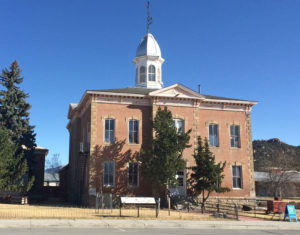By Mike Rosso
I just got off the phone with an old friend on the east coast. I told him about how dry it’s been here and he informed me about how much rain they’ve been getting. Apparently all of our June moisture found its way to New Jersey, leaving us high and dry – literally.
I was in Pagosa Springs in early June and saw the smoke plume from Durango’s 412 Fire heading east towards the Continental Divide. Heading back over Wolf Creek Pass, I witnessed the smoke-filled San Luis Valley; the Sangre De Cristo range nearly obscured from view.
A few days later, the smoke found its way to the Upper Arkansas Valley and was evident in the haze, in the air and the acrid smell of burnt timber. The situation on the Western Slope was so dire that officials closed the San Juan National Forest to all visitors for the first time in its history. No hikers, no camping, no fishing, no ATVs – closed for business.
The conditions for a fire in Central Colorado are frighteningly high right now. One of many concerns is the number of newcomers to our state who aren’t very savvy about the proper way to have a campfire, and who insist on tossing cigarette butts out their car windows. As I write this, I’m listening to the blowing wind outside and thinking about how susceptible we are right now. A glance at the weather forecast reveals hot and dry conditions for the next week or more.
Are these hot and dry conditions a result of climate change? Earlier in June, the Associated Press sent a reporter to Salida and filed a video report, interviewing several locals to get their take on the changing climate here. One of the respondents was veteran Salida firefighter Mike Sugaski, who noted how much larger forest fires have grown over the years.
Another local, Buel Mattix, who owns a heating and cooling system business, has a waiting list for air conditioners. In the past, he averaged maybe four systems a year. Salida has seen an average increase in warming of 1.9 degrees Fahrenheit since 1988. Nationally, temperatures are up 1.6 degrees in the past 30 years.
We have an article beginning on page eight about a man who is tracing a drop of water from Leadville to the Gulf of Mexico, along the Arkansas River, and he notes the depletion of that river, especially in eastern Colorado.
Whether you believe climate change is man-made or cyclical, the evidence is right outside our doorstep; it is hotter and drier now than it was 30 years ago and, unless there is a dramatic change in weather patterns, we will continue to see water depletion, dried-out fields and larger, more frequent forest fires.
[InContentAdTwo]
On a personal note, my family lost our mom, Mary Favano Rosso on June 12, a little over a month after her 91st birthday. Her passing was not a surprise, she’d been in hospice care for several months and was showing signs of her imminent departure when I visited her in California for her birthday. I was grateful to be able to see her and enjoy some quality time with her before her health took a turn for the worst.
Fortunately, my 96-year-old father, my siblings and their spouses were there throughout, helping with her care and giving Mom much love to see her on her journey to the next world.
Mary was born of Italian immigrant stock in Greenwich, Connecticut, and had many traits of the old world, yet was a modern woman. She worked when she was not raising us, and was left-leaning in her politics. She enjoyed her wine, a good laugh, the New York Yankees, and her only grandchild, my niece Olivia.
A memorial for her will be held in mid-July, taking me away from my work here for several days. This will likely cause a delay in the publication date of our next issue, probably putting the mailing date sometime in the first week of August. I hope our readers will understand and respect the cause for the delay.

